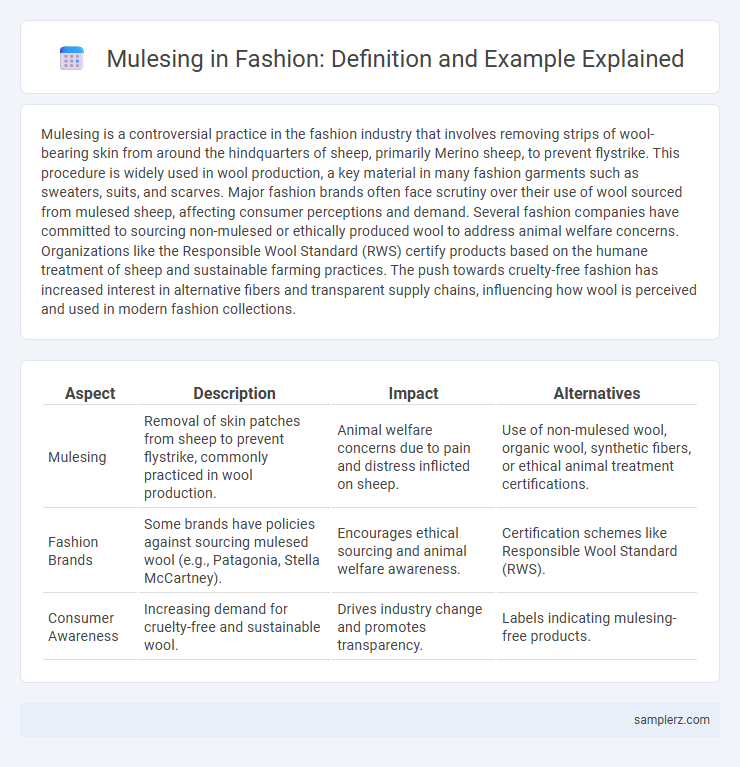Mulesing is a controversial practice in the fashion industry that involves removing strips of wool-bearing skin from around the hindquarters of sheep, primarily Merino sheep, to prevent flystrike. This procedure is widely used in wool production, a key material in many fashion garments such as sweaters, suits, and scarves. Major fashion brands often face scrutiny over their use of wool sourced from mulesed sheep, affecting consumer perceptions and demand. Several fashion companies have committed to sourcing non-mulesed or ethically produced wool to address animal welfare concerns. Organizations like the Responsible Wool Standard (RWS) certify products based on the humane treatment of sheep and sustainable farming practices. The push towards cruelty-free fashion has increased interest in alternative fibers and transparent supply chains, influencing how wool is perceived and used in modern fashion collections.
Table of Comparison
| Aspect | Description | Impact | Alternatives |
|---|---|---|---|
| Mulesing | Removal of skin patches from sheep to prevent flystrike, commonly practiced in wool production. | Animal welfare concerns due to pain and distress inflicted on sheep. | Use of non-mulesed wool, organic wool, synthetic fibers, or ethical animal treatment certifications. |
| Fashion Brands | Some brands have policies against sourcing mulesed wool (e.g., Patagonia, Stella McCartney). | Encourages ethical sourcing and animal welfare awareness. | Certification schemes like Responsible Wool Standard (RWS). |
| Consumer Awareness | Increasing demand for cruelty-free and sustainable wool. | Drives industry change and promotes transparency. | Labels indicating mulesing-free products. |
Understanding Mulesing: Definition and Origins in Fashion
Mulesing is a controversial practice in fashion originating from Australia, involving the removal of strips of wool-bearing skin from sheep to prevent flystrike, predominantly in merino wool production. This method directly impacts the ethical sourcing of wool used in high-end fashion brands, raising significant animal welfare concerns. Understanding mulesing helps consumers make informed choices about sustainable and cruelty-free wool in fashion.
How Mulesing Affects Wool Production Processes
Mulesing, a practice used to remove strips of wool-bearing skin from sheep, significantly impacts wool quality by reducing the incidence of flystrike, which otherwise damages fleece fibers. This procedure alters the texture and uniformity of wool, leading to variations in fiber length and strength that affect spinning and fabric manufacturing. Wool producers adopting non-mulesed practices face challenges in maintaining consistent fiber standards, driving demand for alternative pest control methods within sustainable fashion supply chains.
Brands Associated with Mulesing Practices
Certain fashion brands have faced criticism for sourcing wool from producers practicing mulesing, a controversial procedure used to prevent flystrike in sheep. High-profile companies such as Zara and H&M have been scrutinized for their supply chains linked to mulesed wool, prompting campaigns for more ethical and transparent sourcing. Brands like Patagonia and Icebreaker have distinguished themselves by committing to mulesing-free wool, reflecting growing consumer demand for cruelty-free fashion materials.
Mulesing in the Global Wool Supply Chain
Mulesing, a controversial practice in the global wool supply chain, involves removing strips of skin from sheep to prevent flystrike, significantly impacting ethical standards in fashion. Brands sourcing merino wool are increasingly scrutinized for their supply chain transparency and animal welfare policies due to consumer demand for cruelty-free materials. Innovations like non-mulesed wool and alternative pest control methods are gaining traction, driving sustainable and ethical fashion trends worldwide.
Ethical and Sustainable Alternatives to Mulesing
Ethical and sustainable alternatives to mulesing in fashion include the use of non-mulesed Merino wool sourced from certified farms committed to animal welfare standards such as the Responsible Wool Standard (RWS). Innovations like cryogenic freezing and precision shearing prevent flystrike without harming sheep, providing cruelty-free solutions embraced by brands aiming to reduce their environmental and ethical impact. Sustainable fashion labels prioritize transparency and traceability, supporting regenerative agriculture practices that enhance biodiversity and promote sheep well-being.
Fashion Industry Responses to Mulesing Criticism
Fashion brands like Patagonia and Icebreaker have responded to mulesing criticism by sourcing non-mulesed Merino wool, promoting ethical wool certifications such as the Responsible Wool Standard (RWS). Major retailers including H&M and Zara have committed to transparency and animal welfare policies, phasing out mulesing practices in their supply chains. Consumer demand for cruelty-free fashion continues to drive industry shifts towards sustainable and humane sourcing of animal fibers.
Animal Welfare Concerns Related to Mulesing
Mulesing, a surgical procedure performed on Merino sheep to prevent flystrike, raises significant animal welfare concerns within the fashion industry due to its painful nature and ethical implications. Despite its use to protect sheep, animal rights organizations advocate for alternative, cruelty-free wool production methods that avoid mulesing altogether. Brands committed to sustainable and ethical fashion increasingly prioritize sourcing wool from mulesing-free suppliers to address consumer demand for animal-friendly practices.
Consumer Awareness and Demands Regarding Mulesing
Growing consumer awareness about animal welfare has significantly increased demands for fashion brands to reject mulesing practices in wool production. Shoppers actively seek certifications like Responsible Wool Standard (RWS) to ensure cruelty-free sourcing and ethical treatment of sheep. This shift is driving designers and retailers to adopt transparent, sustainable supply chains that prioritize animal-friendly alternatives to mulesing.
Certifications and Labels Addressing Mulesing-Free Wool
Certifications like ZQ Merino and The Responsible Wool Standard (RWS) play a crucial role in guaranteeing mulesing-free wool in fashion products, ensuring ethical animal treatment. Brands displaying labels such as "Mulesing-Free" or "Ethically Sourced Wool" signal consumer assurance of cruelty-free practices in wool production. These certifications support sustainable fashion by promoting transparency and animal welfare across the supply chain.
The Future of Mulesing in Sustainable Fashion
The future of mulesing in sustainable fashion hinges on innovative alternatives such as breeding programs and ethical wool sourcing, which reduce animal cruelty while maintaining high-quality materials. Brands committed to transparency are increasingly adopting certifications like Responsible Wool Standard (RWS) to ensure cruelty-free practices in their supply chains. Advances in tissue engineering and synthetic fibers also offer promising solutions to phase out mulesing entirely, aligning fashion with evolving consumer demand for animal welfare and sustainability.

example of mulesing in fashion Infographic
 samplerz.com
samplerz.com